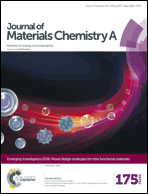We are pleased to announce that the 2015 Impact Factors for Journal of Materials Chemistry A, B and C have risen to a record high:
Journal of Materials Chemistry A – 8.262
Journal of Materials Chemistry B – 4.872
Journal of Materials Chemistry C – 5.066
We would like to thank all of our authors, referees, and Editorial and Advisory Board members for all their hard work and contributions to the success of the Journal of Materials Chemistry family.
Submit your next high impact paper to Journal of Materials Chemistry A, B or C and enjoy all the benefits of being a Royal Society of Chemistry author.

Check out the following selection of highly cited articles that contributed to these Impact Factors:
Graphene-based nanocomposites for energy storage and conversion in lithium batteries, supercapacitors and fuel cells
Nasir Mahmood, Chenzhen Zhang, Han Yin and Yanglong Hou
J. Mater. Chem. A, 2014, 2, 15-32
Recent advances of non-fullerene, small molecular acceptors for solution processed bulk heterojunction solar cells
Ala’a F. Eftaiha, Jon-Paul Sun, Ian G. Hill and Gregory C. Welch
J. Mater. Chem. A, 2014, 2, 1201-1213
Mussel-inspired self-coating at macro-interface with improved biocompatibility and bioactivity via dopamine grafted heparin-like polymers and heparin
Lang Ma, Hui Qin, Chong Cheng, Yi Xia, Chao He, Chuanxiong Nie, Lingren Wang and Changsheng Zhao
J. Mater. Chem. B, 2014, 2, 363-375
Aggregation induced emission-based fluorescent nanoparticles: fabrication methodologies and biomedical applications
Xiqi Zhang, Xiaoyong Zhang, Lei Tao, Zhenguo Chi, Jiarui Xu and Yen Wei
J. Mater. Chem. B, 2014, 2, 4398-4414
Flexible planar/fiber-architectured supercapacitors for wearable energy storage
Xin Cai, Ming Peng, Xiao Yu, Yongping Fu and Dechun Zou
J. Mater. Chem. C, 2014, 2, 1184-1200
Carbon quantum dots: synthesis, properties and applications
Youfu Wang and Aiguo Hu
J. Mater. Chem. C, 2014, 2, 6921-6939
Comments Off on Journal of Materials Chemistry A, B and C 2015 Impact Factors














 These 3D models show heterotopic ossification samples before (A) and after (B) treatment with hexametaphosphate
These 3D models show heterotopic ossification samples before (A) and after (B) treatment with hexametaphosphate

